Buoyancy Effect on the Unsteady Diffusive Convective Flow of a Carreau Fluid Passed over a Coated Disk with Energy Loss
Abstract
:1. Introduction
2. Method and Material
3. Results and Discussion
4. Conclusions
- The speed of the fluid on the surface helps to decelerate the momentum boundary layer of a Carreau fluid, whereas accelerates the boundary layer, and shows dual behavior on the momentum boundary layer.
- The temperature of the fluid improves with and , whereas it drops with .
- The concentration of the fluid declines with and improves with fluid velocity on the coated surface .
- The numerical values of the skin-friction coefficients show that the drag force on the coated surface of the disk drops with the rise in the viscoelastic fluid parameter
- The mathematical results of the Nusselt number indicates that the heat transfer rate on the conducting surface declines with the increase in
- The numerical values of the Sherwood number shows that the concentration rate on the coated surface surges with the rise in Sc.
- In the present study, authors have considered a linear type of velocity on a coated surface that can also be assumed to be nonlinear or exponential in future work.
Author Contributions
Funding
Institutional Review Board Statement
Informed Consent Statement
Data Availability Statement
Conflicts of Interest
Nomenclature
| W | Axial component of velocity | [m/s] |
| Ambient temperature | [K] | |
| Cauchy stress tensor | ] | |
| Cross fluid temperature | [K] | |
| Cross fluid viscosity | ] | |
| Cross time constant | [Rad] | |
| Dimensionless parameters | ||
| Dimensionless temperature | ||
| Dimensionless similarity variable | ||
| Eckert number | ||
| Electrical conductivity of fluid | [S/m] | |
| First Rivlin–Ericksen tensor | ] | |
| Fluid density | ||
| Heat flux at the surface | ] | |
| Infinite shear-rate viscosity | [kg/ms] | |
| Kinematic viscosity | ||
| Local Nusselt number | ||
| Local Reynold’s number | ||
| Local wall shear stress | ||
| Local Weissenberg number | ||
| Prandtl number | ||
| Pressure | ] | |
| u | Radial component of velocity | [m/s] |
| Schmidt number | ||
| Shear rate | [s−1] | |
| Sherwood number | ||
| Space variables | [m] | |
| Specific heat at constant pressure | [J/kg K] | |
| Stream function | [kg/ms] | |
| Stretching velocity | ] | |
| Surface temperature | [K] | |
| Thermal conductivity | [W/mK] | |
| T | Time variable | ] |
| Velocity field | ] | |
| Zero shear-rate viscosity | ] |
References
- Benkreira, H.; Patel, R.; Edwards, M.F. Classification and analyses of coating flows. J. Non-Newton. Fluid Mech. 1994, 54, 437–447. [Google Scholar] [CrossRef] [Green Version]
- Middleman, S. Fundamentals of Polymer Processing; McGraw-Hill: New York, NY, USA, 1977. [Google Scholar]
- Saini, P.K.; Kumar, P.; Tondon, P. Thermal elastohydrodynamic lubrication characteristics of couple stress fluids in rolling/sliding line contacts. J. Eng. Tribol. 2007, 221, 141–153. [Google Scholar] [CrossRef]
- Chien, C.H.; Jang, J.Y. Numerical and experimental studies of thin liquid film flow between two forward-rollers. J. Mech. Sci. Technol. 2007, 21, 1892–1900. [Google Scholar] [CrossRef]
- Khan, U.; Zaib, A.; Ishak, A.; Al-Mubaddel, F.S.; Bakar, S.A. Computational modeling of hybrid Sisko nanofluid flow over a porous radially heated shrinking/stretching disc. Coatings 2021, 11, 1242. [Google Scholar] [CrossRef]
- Khashi’ie, N.S.; Waini, I.; Pop, I.; Zainal, N.A.; Kasim, A.R. Axisymmetric hybrid nanofluid flow due to a convectively heated stretching/shrinking disk. J. Adv. Res. Fluid Mech. Therm. Sci. 2021, 85, 113–124. [Google Scholar]
- Khashi’ie, N.S.; Arifin, N.M.; Pop, I. Unsteady axisymmetric radiative Cu-Al2O3/H2O flow over a radially stretching/shrinking surface. Chin. J. Phys. 2022, 78, 169–179. [Google Scholar] [CrossRef]
- Ibrahim, M. Numerical analysis of time-dependent flow of viscous fluid due to a stretchable rotating disk with heat and mass transfer. Results Phys. 2020, 18, 103242. [Google Scholar] [CrossRef]
- Ellahi, R. Recent Trends in coatings and thin film: Modeling and application. Coatings 2020, 10, 777. [Google Scholar] [CrossRef]
- Rashidi, M.M.; Erfani, E.; Bég, O.A.; Ghosh, S.K. Modified differential transform method (DTM) simulation of hydromagnetic multi-physical flow phenomena from a rotating disk. World J. Mech. 2011, 1, 217–230. [Google Scholar] [CrossRef] [Green Version]
- Ijaz, N.; Riaz, A.; Zeeshan, A.; Ellahi, R.; Sait, S.M. Buoyancy driven flow with gas-liquid coatings of peristaltic bubbly flow in elastic walls. Coatings 2020, 10, 115. [Google Scholar] [CrossRef] [Green Version]
- Ellahi, R.; Zeeshan, A.; Hussain, F.; Abbas, T. Thermally charged MHD bi-phase flow coatings with non-Newtonian nanofluid and hafnium particles along slippery walls. Coatings 2019, 9, 300. [Google Scholar] [CrossRef]
- Ur Rasheed, H.; AL-Zubaidi, A.; Islam, S.; Saleem, S.; Khan, Z.; Khan, W. Effects of Joule heating and viscous dissipation on magnetohydrodynamic boundary layer flow of Jeffrey nanofluid over a vertically stretching cylinder. Coatings 2021, 11, 353. [Google Scholar] [CrossRef]
- Ellahi, R.; Zeeshan, A.; Hussain, F.; Abbas, T. Study of shiny film coating on multi-fluid flows of a rotating disk suspended with nano-sized silver and gold particles: A comparative analysis. Coatings 2018, 8, 422. [Google Scholar] [CrossRef] [Green Version]
- Ramzan, M.; Liaquet, A.; Kadry, S.; Yu, S.; Nam, Y.; Lu, D. Impact of second-order slip and double stratification coatings on 3d mhd williamson nanofluid flow with cattaneo–christov heat flux. Coatings 2019, 9, 849. [Google Scholar] [CrossRef] [Green Version]
- Khan, M.; Salahuddin, T.; Malik, M.Y. Impact of enhancing diffusion on Carreau–Yasuda fluid flow over a rotating disk with slip conditions. J. Braz. Soc. Mech. Sci. 2019, 41, 1–8. [Google Scholar] [CrossRef]
- Khan, M.; Salahuddin, T.; Sherif El, S.M.; Abdo, H.S. Wall slip characteristics on the dynamics of radioactive Carreau fluid flow subjected to thermophysical properties of the rotating boundary layer. Int. Commun. Heat. Mass. Transf. 2020, 119, 104960. [Google Scholar] [CrossRef]
- Mair Khan Salahuddin, T.; Elmasry, Y.; Aly, S.; Khan, F. Zero mass flux and convection boundary condition effects on Carreau-Yasuda fluid flow over a heated plat. Radiat. Phys. Chem. 2020, 177, 109152. [Google Scholar]
- Hassan, M.; Issakhov, A.; Khan, S.U.; Assad, M.E.; Hani, E.H.; Rahimi-Gorji, M.; Nadeem, S.; Khan, S.U. The effects of zero and high shear rates viscosities on the transportation of heat and mass in boundary layer regions: A non-Newtonian fluid with Carreau model. J. Mol. Liq. 2020, 1, 113991. [Google Scholar] [CrossRef]
- Saranya, S.; Al-Mdallal, Q.M.; Animasaun, I.L. Lhifted legendre collocation analysis of time-dependent Casson fluids and Carreau fluids conveying tiny particles and gyrotactic microorganisms: Dynamics on static and moving surfaces. Arab J. Sci. Eng. 2022, 62, 1–23. [Google Scholar]
- Farooq, U.; Afridi, M.I.; Qasim, M.; Lu, D. Transpiration and viscous dissipation effects on entropy generation in hybrid nanofluid flow over a nonlinear radially stretching disk. Entropy 2018, 20, 668. [Google Scholar] [CrossRef] [Green Version]
- Bhatti, M.M.; Michaelides, E.E. Oldroyd 6-constant Electro-magneto-hydrodynamic fluid flow through parallel micro-plates with heat transfer using Darcy-Brinkman-Forchheimer model: A parametric investigation. Math. Eng. 2022, 5, 1–19. [Google Scholar] [CrossRef]
- Sharma, B.K.; Gandhi, R.; Bhatti, M.M. Entropy analysis of thermally radiating MHD slip flow of hybrid nanoparticles (Au-Al2O3/Blood) through a tapered multi-stenosed artery. Chem. Phys. Lett. 2022, 790, 139348. [Google Scholar] [CrossRef]
- Afridi, M.I.; Ashraf, M.U.; Qasim, M.; Wakif, A. Numerical simulation of entropy transport in the oscillating fluid flow with transpiration and internal fluid heating by GGDQM. Waves Random Complex Media 2022, 32, 1–19. [Google Scholar] [CrossRef]
- Abbas, T.; Rehman, S.; Shah, R.A.; Idrees, M.; Qayyum, M. Analysis of MHD Carreau fluid flow over a stretching permeable sheet with variable viscosity and thermal conductivity. Phys. A Stat. Mech. Its Appl. 2020, 551, 124225. [Google Scholar] [CrossRef]
- Hafeez, A.; Yasir, M.; Khan, M.; Malik, M.Y.; Alqahtani, A.S. Buoyancy effect on the chemically reactive flow of Cross nanofluid over a shrinking surface: Dual solution. Int. Commun. Heat Mass Transf. 2021, 126, 105438. [Google Scholar] [CrossRef]
- Hamid, A.; Chu, Y.M.; Khan, M.I.; Kumar, R.N.; Gowd, R.P.; Prasannakumara, B.C. Critical values in axisymmetric flow of magneto-Cross nanomaterial towards a radially shrinking disk. Int. J. Mod. Phys. 2021, 35, 2150105. [Google Scholar] [CrossRef]
- Jamaludin, A.; Nazar, R.; Pop, I. Mixed convection stagnation-point flow of Cross fluid over a shrinking sheet with suction and thermal radiation. Phys. A Stat. Mech. Its Appl. 2022, 585, 126398. [Google Scholar] [CrossRef]
- Maleki, H.; Safaei, M.R.; Togun, H.; Dahari, M. Heat transfer and fluid flow of pseudo-plastic nanofluid over a moving permeable plate with viscous dissipation and heat absorption/generation. J. Therm. Anal. Calorim 2019, 135, 1643–1654. [Google Scholar] [CrossRef]
- Izadi, M.; Sheremet, M.; Alshehri, H.M.; Ambreen, T.; Doranehgard, M.H. Numerical study on charging process inside a grid-structure thermal storage. J. Energy Storage 2022, 45, 103522. [Google Scholar] [CrossRef]
- Tian, Z.; Arasteh, H.; Parsian, A.; Karimipour, A.; Safaei, M.R.; Nguyen, T.K. Estimate the shear rate & apparent viscosity of multi-phased non-Newtonian hybrid nanofluids via new developed support vector machine method coupled with sensitivity analysis. Physica A 2019, 535, 122456. [Google Scholar]
- Turkyilmazoglu, M. Equivalence of ratio and residual approaches in the homotopy analysis method and some applications in nonlinear science and engineering. Comput. Model Eng. Sci. 2019, 120, 63–81. [Google Scholar] [CrossRef] [Green Version]
- Gibanov, N.S.; Sheremet, M.A.; Oztop, H.F.; Al-Salem, K. MHD natural convection and entropy generation in an open cavity having different horizontal porous blocks saturated with a ferrofluid. J. Magn. Magn. Mater. 2018, 452, 193–204. [Google Scholar] [CrossRef]
- Sheremet, M.A.; Rashidi, M.M. Thermal convection of nano-liquid in an electronic cabinet with finned heat sink and heat generating element. Alex. Eng. J. 2021, 60, 2769–2778. [Google Scholar] [CrossRef]
- Ellahi, R.; Bhatti, M.M.; Khalique, C.M. Three-dimensional flow analysis of Carreau fluid model induced by peristaltic wave in the presence of magnetic field. J. Mol. Liq. 2017, 241, 1059–1068. [Google Scholar]
- Tayebi, T.; Chamkha, A.J. Entropy generation analysis during MHD natural convection flow of hybrid nanofluid in a square cavity containing a corrugated conducting block. Int. J. Numer. Methods Heat Fluid Flow 2020, 30, 1115–1136. [Google Scholar] [CrossRef]
- Rehman, K.U.; Awan, F.J.; Qaiser, A.; Mehmood, A. On Joule heating magnetized axisymmetric Cross fluid model: A computational statistics. Phys. A Stat. Mech. Its Appl. 2019, 534, 122–134. [Google Scholar] [CrossRef]
- Mehmood, A. Viscous Flows: Stretching and Shrinking of Surfaces; Springer: Berlin/Heidelberg, Germany, 2017. [Google Scholar]
- Schlichting, H.; Kestin, J. Boundary Layer Theory; McGraw-Hill: New York, NY, USA, 1961; Volume 121. [Google Scholar]
- Ariel, P.D. Axisymmetric flow of a second grade fluid past a stretching sheet. Int. J. Eng. Sci. 2001, 39, 529–553. [Google Scholar] [CrossRef]
- Hayat, T.; Sajid, M. Analytic solution for axisymmetric flow and heat transfer of a second grade fluid past a stretching sheet. Int. J. Heat Mass Transf. 2007, 50, 75–84. [Google Scholar] [CrossRef]
- Khan, M.; Rahman, M.U.; Manzur, M. Axisymmetric flow and heat transfer to modified second grade fluid over a radially starching sheet. Results Phys. 2017, 7, 878–889. [Google Scholar] [CrossRef]
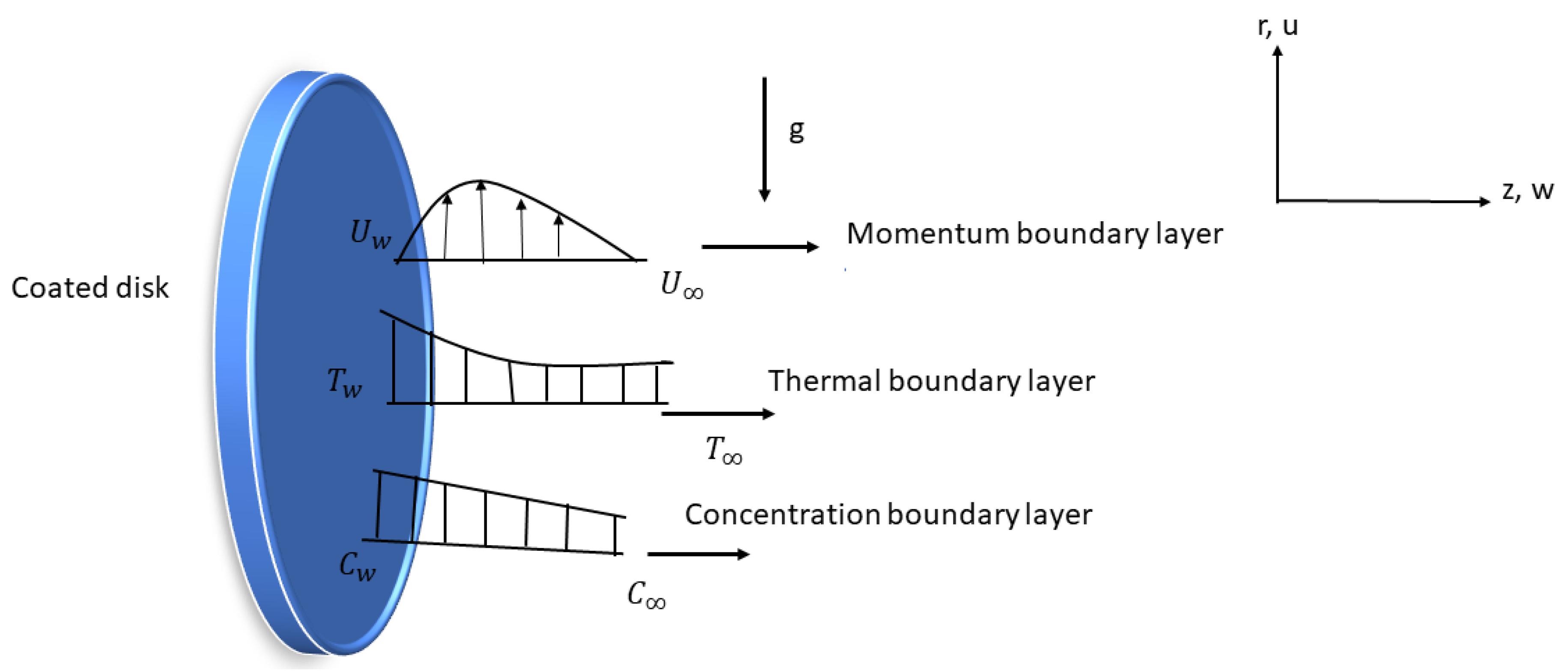
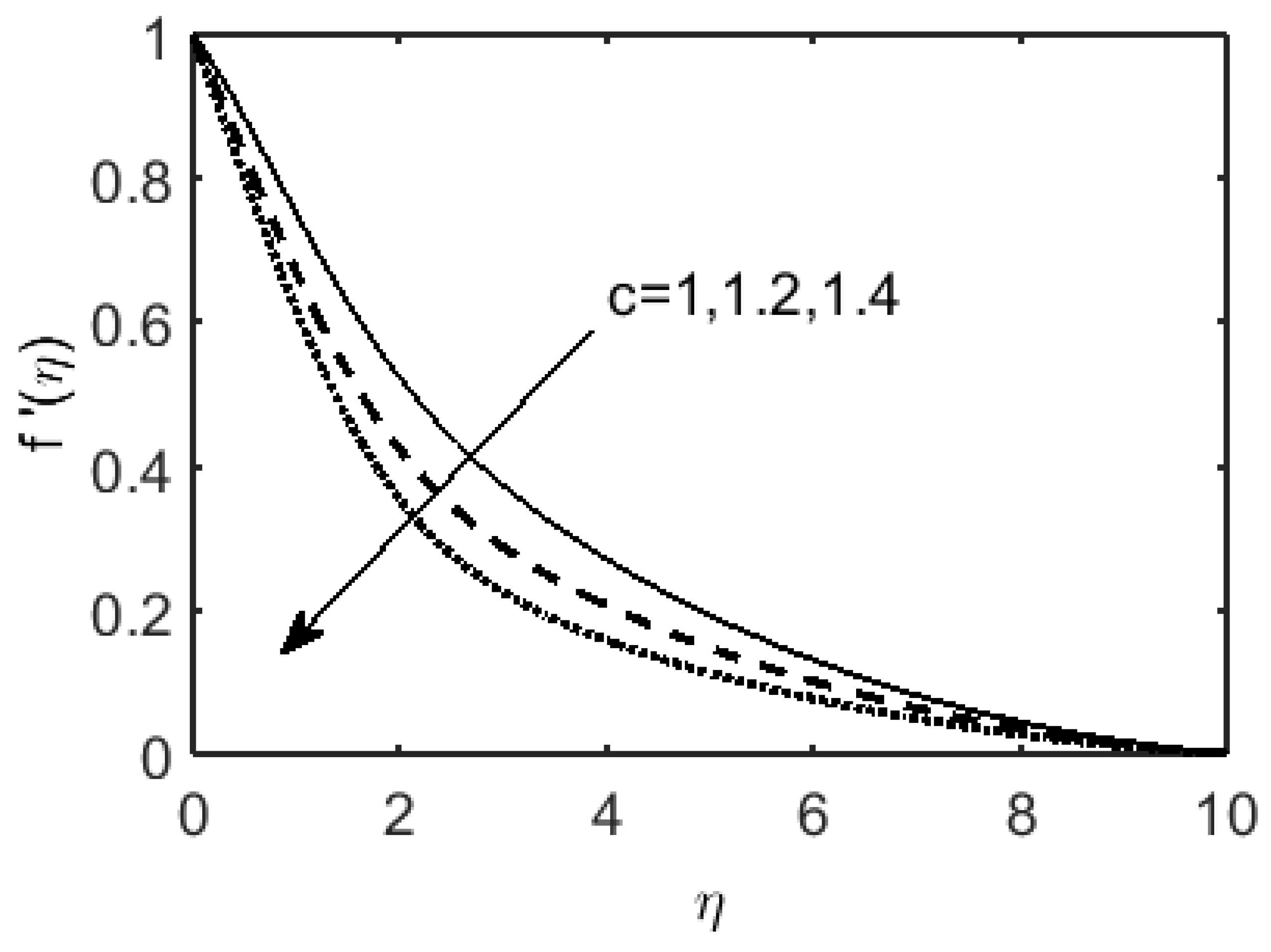
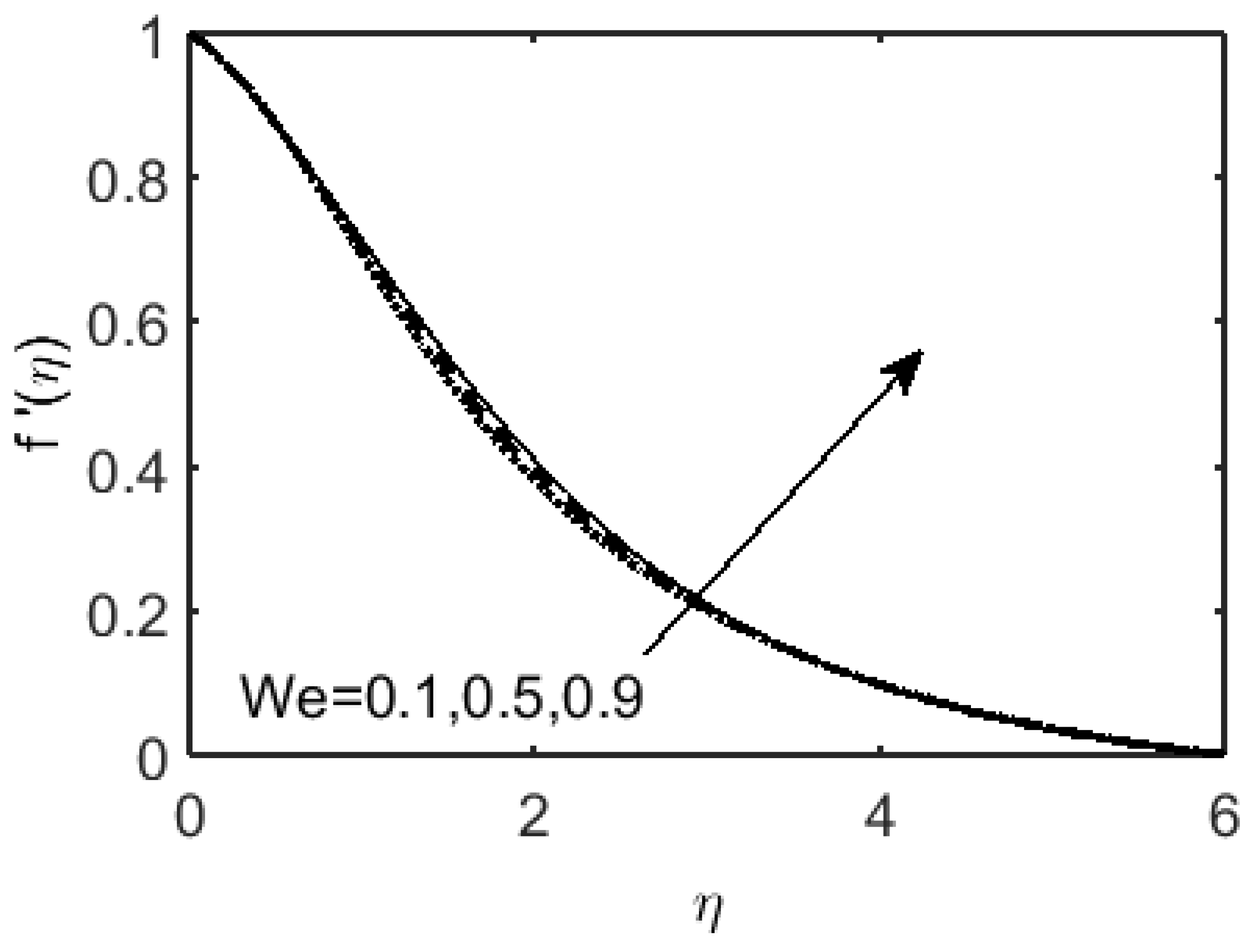

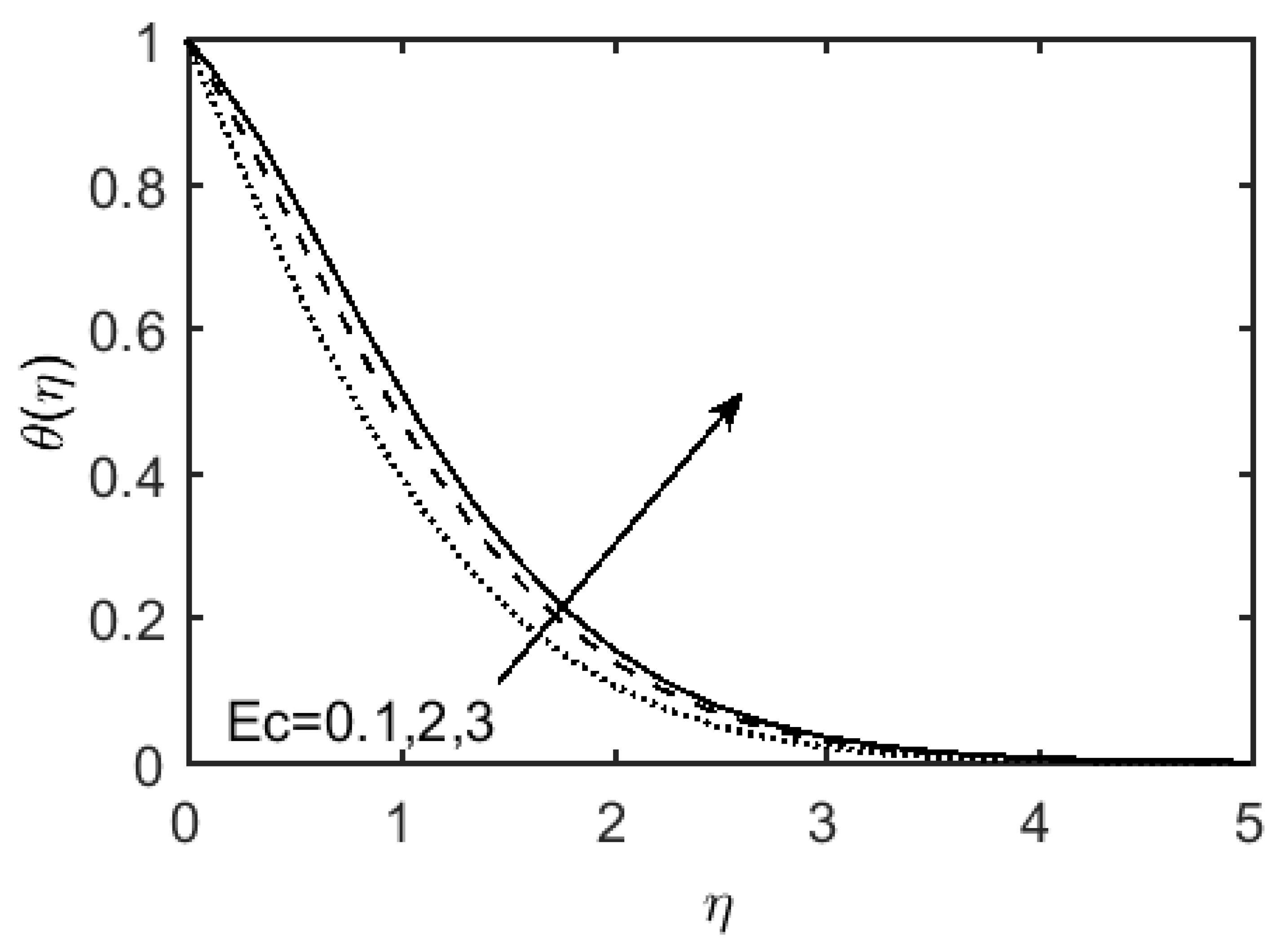
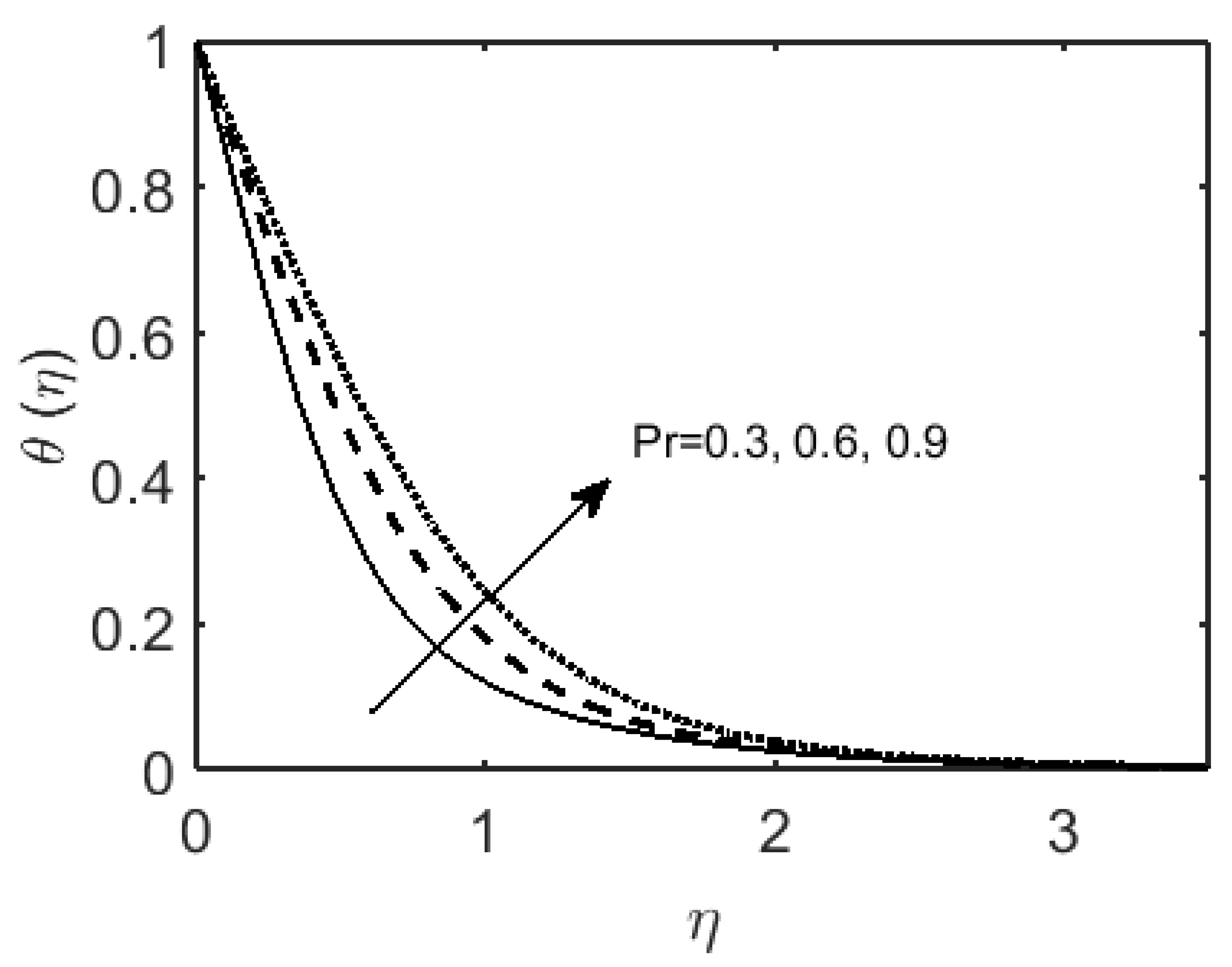
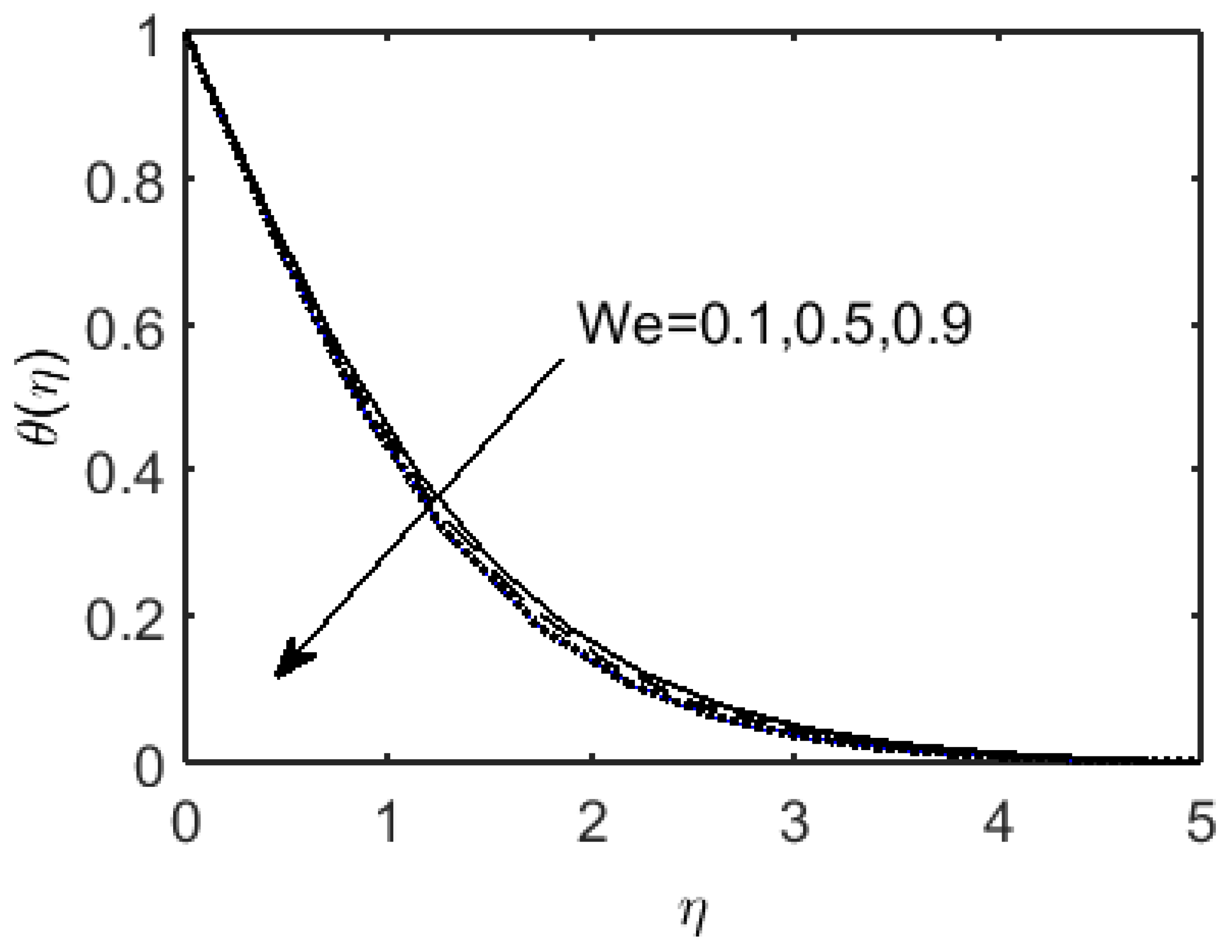

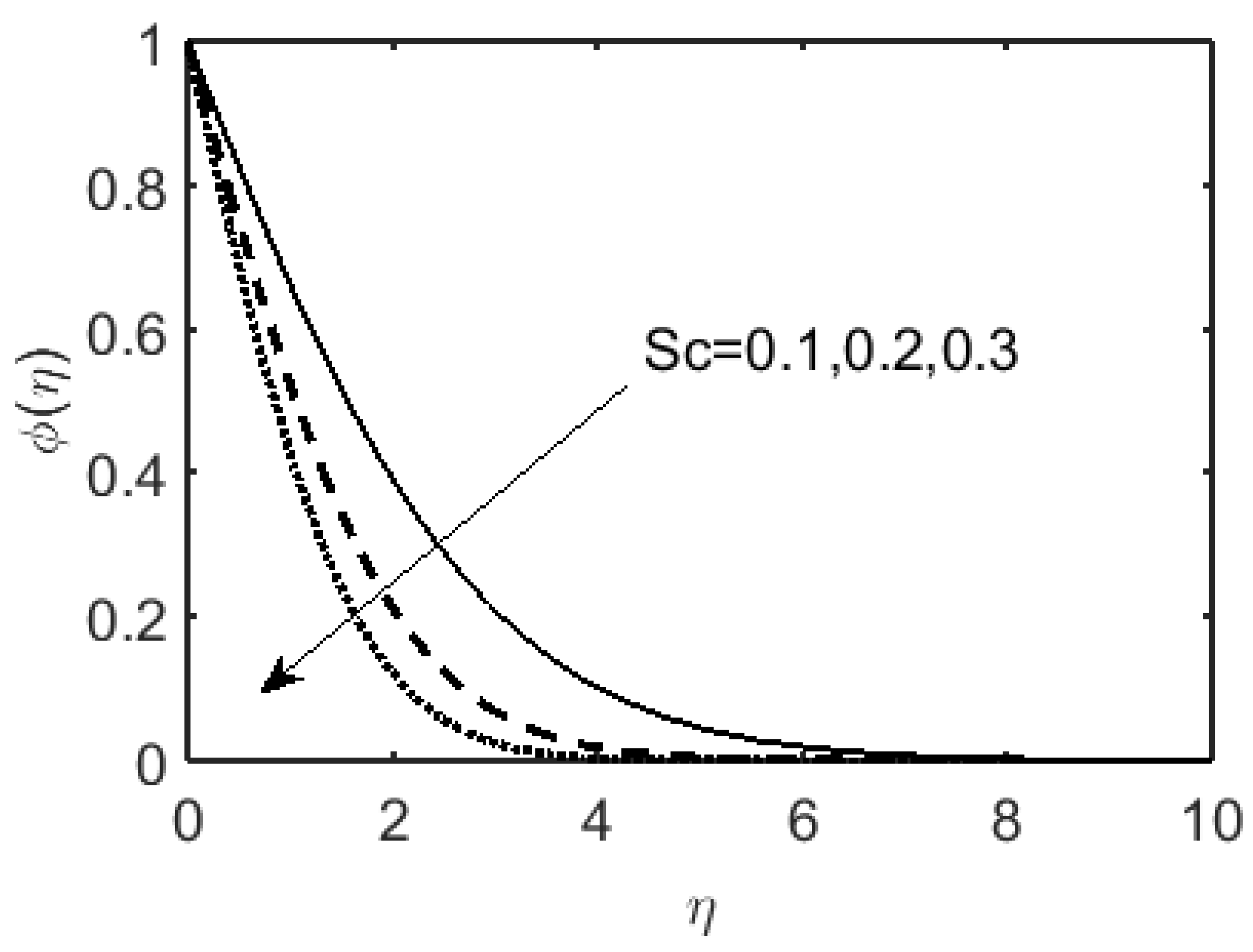
| = | |||
| 0.1 | 0.88008 | 0.58647 | 0.37169 |
| 0.3 | 0.79701 | 0.59361 | 0.3766 |
| 0.5 | 0.72481 | 0.60082 | 0.38182 |
| 0.7 | 0.66180 | 0.60799 | 0.38731 |
| 0.9 | 0.60660 | 0.61497 | 0.39302 |
| = | |
| 0.2 | 2.0853 |
| 0.4 | 1.4543 |
| 0.6 | 1.1674 |
| 0.8 | 0.99422 |
| 1.0 | 0.87521 |
| 0.2 | 0.36651 |
| 0.4 | 0.53334 |
| 0.6 | 0.68433 |
| 0.8 | 0.81852 |
| 1.0 | 0.93893 |
Publisher’s Note: MDPI stays neutral with regard to jurisdictional claims in published maps and institutional affiliations. |
© 2022 by the authors. Licensee MDPI, Basel, Switzerland. This article is an open access article distributed under the terms and conditions of the Creative Commons Attribution (CC BY) license (https://creativecommons.org/licenses/by/4.0/).
Share and Cite
Awan, F.J.; Maqbool, K.; Sait, S.M.; Ellahi, R. Buoyancy Effect on the Unsteady Diffusive Convective Flow of a Carreau Fluid Passed over a Coated Disk with Energy Loss. Coatings 2022, 12, 1510. https://doi.org/10.3390/coatings12101510
Awan FJ, Maqbool K, Sait SM, Ellahi R. Buoyancy Effect on the Unsteady Diffusive Convective Flow of a Carreau Fluid Passed over a Coated Disk with Energy Loss. Coatings. 2022; 12(10):1510. https://doi.org/10.3390/coatings12101510
Chicago/Turabian StyleAwan, Farah Jabeen, Khadija Maqbool, Sadiq M. Sait, and Rahmat Ellahi. 2022. "Buoyancy Effect on the Unsteady Diffusive Convective Flow of a Carreau Fluid Passed over a Coated Disk with Energy Loss" Coatings 12, no. 10: 1510. https://doi.org/10.3390/coatings12101510






